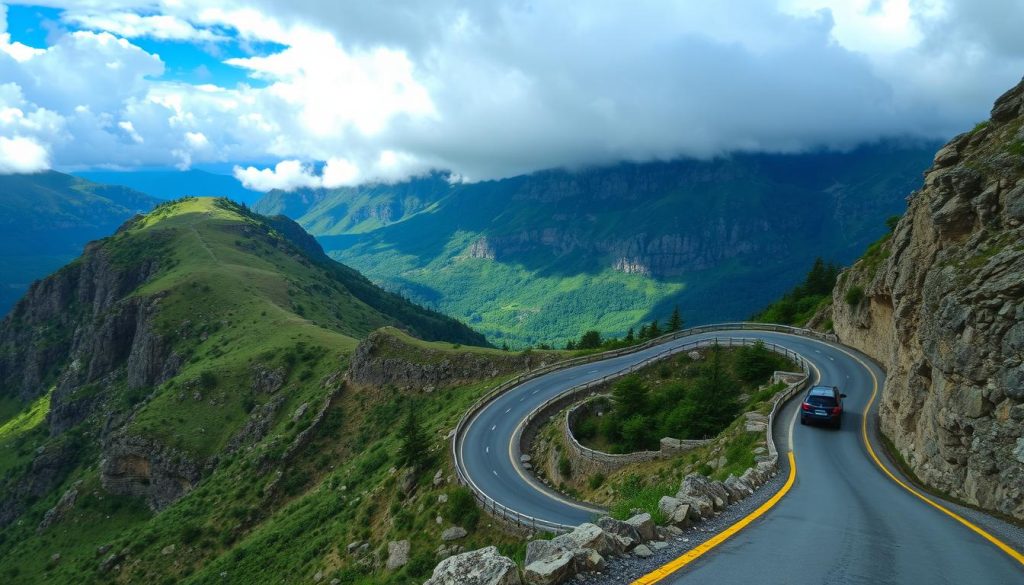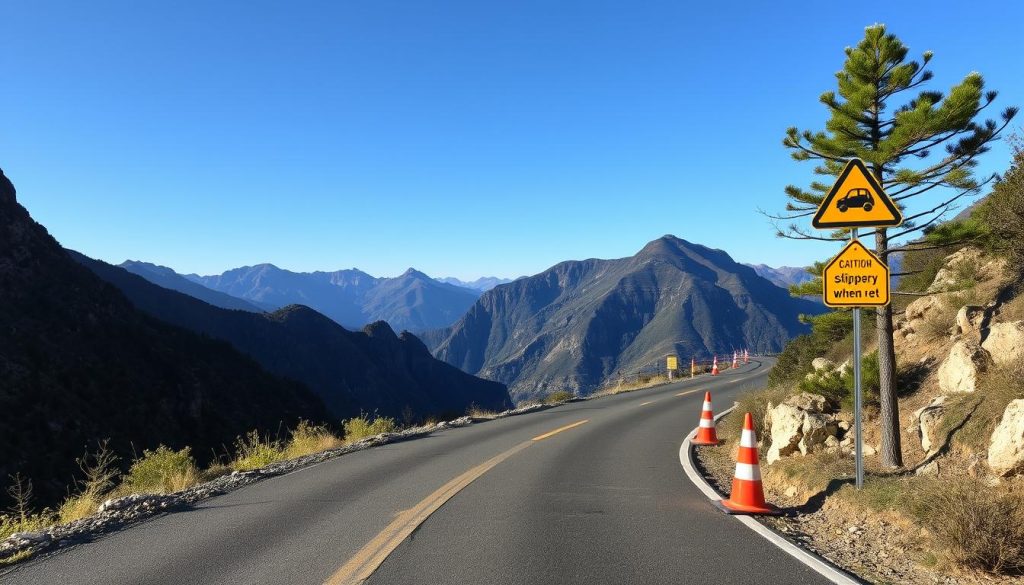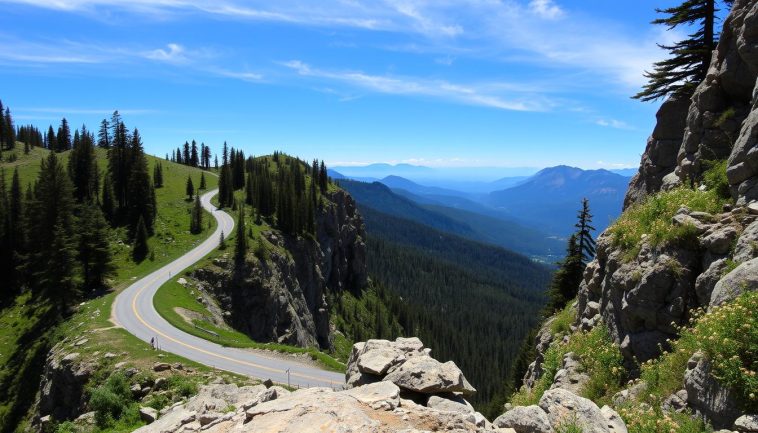anxietywhendriving.com highly recommends The Driving Fear Program to overcome your Driving Anxiety 90 Days Money Back Guarantee!
-->Click Here<--

Did you know that about 1 in 5 drivers feel really anxious on narrow, winding mountain roads? This fear can stop even the most confident drivers from going on scenic road trips. They miss out on amazing views and exciting experiences. But, with the right strategies and preparation, you can overcome your fear and enjoy the ride.
Key Takeaways
- Understand the common triggers and sources of fear when driving on narrow mountain roads
- Develop defensive driving techniques to stay focused and alert on challenging terrain
- Learn strategies to build confidence and manage anxiety, such as visualization and deep breathing
- Prepare for mountain road trips with proper planning and packing to minimize stress
- Appreciate the scenic views and surroundings to enjoy the journey, not just the destination
Understanding the Fear of Driving on Narrow Mountain Roads
Many people fear driving on narrow mountain roads. This fear can come from various sources. For example, steep drop-offs, sun glare, and feeling out of control can trigger it. Past car accidents or near-misses can make this fear worse. This fear is often linked to fear of driving.
Common Experiences and Triggers
Those who fear driving on narrow mountain roads often feel tense and anxious. They worry about steep drop-offs and hairpin turns. Sun glare and feeling out of control can make this fear worse.
“The thought of driving on a narrow mountain road with a steep drop-off on one side fills me with dread. I can feel my heart racing and my palms getting sweaty just imagining it.”
For some, the fear of heights plays a big role in their panic attacks on mountain roads. Feeling like they’re on the edge can be very stressful.
Understanding why you fear driving is the first step to overcoming it. By knowing what triggers your fear, you can start to manage it. This way, you can feel more confident on the road.
Preparing for a Mountain Road Trip
Starting a mountain road trip is exciting but needs careful planning. You must prepare for the challenges of driving on narrow, winding roads. Planning your trip well helps make it stress-free and enjoyable.
Start by researching the scenic routes you’ll take. Learn about the road conditions, hazards, and landmarks. This knowledge boosts your confidence and helps plan stops to manage your anxiety.
- Research the road conditions and potential challenges along your planned route.
- Identify any notable landmarks or viewpoints that can serve as rest stops or destinations.
- Plan alternative routes or detours in case of unexpected road closures or hazardous conditions.
Make sure your vehicle is ready for the trip. Get a thorough check-up to ensure safety and comfort. Also, pack emergency kits, snacks, and calming music to help with anxiety.
By carefully planning your mountain road trip, you’ll enjoy the scenic views and thrilling drives. With the right preparation, you’ll navigate narrow roads with confidence and ease.
Defensive Driving Techniques for Narrow Mountain Roads
Driving on narrow mountain roads needs special skills to stay safe. By using these techniques, you can feel more in control and confident. This reduces the stress and worry that comes with driving in tough places.
Staying Focused and Alert
It’s key to stay sharp and alert on narrow mountain roads. Avoid distractions and keep your eyes on the road. Look out for things like loose rocks, debris, or cars coming the other way. Stay calm and ready to make quick decisions.
- Drive slowly and steadily to keep control and be able to move easily.
- Watch the center line or the edge of the road to stay in your lane.
- Get ready for sharp turns, steep hills, and other road changes by adjusting your speed and steering.
| Defensive Driving Technique | Benefit |
|---|---|
| Maintaining a Constant Speed | Improved vehicle control and handling on narrow, winding roads |
| Careful Monitoring of Road Edges | Enhanced awareness of lane positioning and proximity to potential hazards |
| Anticipating Road Changes | Ability to make smooth, proactive adjustments to speed and steering |
Using these defensive driving techniques will help you drive confidently on narrow roads. Stay alert, focused, and ready for the challenges of mountain road driving. This way, you can enjoy the beautiful views without feeling anxious.
Overcoming Fear of Driving on Narrow Mountain Roads
Overcoming fear of driving on narrow mountain roads is a journey. It needs a mix of confidence building, anxiety management, and sometimes professional help. With practice, techniques, and support, you can face your fears.
Exposure therapy is a key strategy. It involves gradually facing the challenging driving conditions. By doing this, along with calming exercises and staying present, you can beat your fears. Regular practice boosts confidence and lessens anxiety.
- Incorporate breathing exercises and mindfulness techniques to stay calm and focused during challenging mountain drives.
- Gradually increase the difficulty of your mountain road trips, starting with less intimidating routes and gradually moving towards more challenging terrain.
- Seek the support of a mental health professional or a driving instructor who specializes in driving anxiety management and confidence building techniques.
By using a multi-faceted approach, drivers can conquer their fear of narrow mountain roads. They can enjoy the stunning views and feel a great sense of achievement.
“The only way to overcome your fear is to face it head-on, with a plan and the right support. Conquering the narrow mountain roads is an empowering experience that will transform your perspective on driving.”
Scenic Route Confidence: Enjoying the Journey
Once you get past the fear of driving on narrow mountain roads, the trip becomes fun and memorable. By focusing on the scenic route confidence, the breathtaking views, and the natural environment, you can change your mindset. This shift makes the journey more enjoyable and helps you feel in control.
Appreciating the Views and Surroundings
As you drive on the winding mountain roads, take time to appreciate the mountain views and the stunning landscapes. Slow down, be mindful of your driving, and enjoy the moment. This change in view can turn a stressful drive into an amazing adventure.
- Pause at viewpoints to fully take in the views
- Notice the changing textures and colors of the landscape
- Tune in to the sights, sounds, and smells of nature
By embracing the scenic route confidence and appreciating the mountain views, you can overcome your fears. You’ll also enjoy the journey and make memories that last.
Hairpin Turn Navigation and Steep Grade Management
Driving on mountain roads can be exciting but also challenging. It’s especially tough when you face hairpin turns and steep grades. Learning how to handle these is key for a safe and fun trip through the beautiful views.
When you see a hairpin turn, slow down and take a wide path through it. This keeps your car in control and lowers the chance of losing balance. Knowing how your car moves and its weight helps you manage the turn better.
- Slow down early before the hairpin turn.
- Take a wide path through the turn for more stability.
- Watch how your car handles and adjust speed and steering as needed.
Steep grades need different driving skills. To safely go up or down, keep a steady speed and be ready for any problem. This might include losing traction or needing to use the engine to brake.
- Downshift to a lower gear to help brake and keep control on steep descents.
- Avoid sudden stops or speeding up, as it can cause you to lose control.
- Think about your car’s weight and speed, and adjust your driving accordingly.
By learning these mountain road driving techniques, like hairpin turn navigation and steep grade management, drivers can become more aware and confident on mountain roads.

Road Trip Preparation: Minimizing Anxiety
Getting ready for a mountain road trip is key to lessening anxiety and making the trip enjoyable. It’s important to plan your route well and pack the right supplies. This way, you’ll feel confident and in control, even on tough mountain roads.
Planning and Packing for Mountain Driving
First, research the roads and any obstacles you might face. Look for updates on construction, weather, and road conditions. Knowing what to expect can help you plan for challenges like narrow roads or steep hills.
Then, prepare an emergency kit with essentials like a spare tire and jumper cables. Don’t forget snacks, water, and comfort items like music or podcasts. Being prepared can help you stay calm and focused on your mountain drive.
| Road Trip Preparation Checklist | Mountain Driving Essentials |
|---|---|
| Research route and road conditions Check weather forecasts Plan for potential challenges Pack emergency kit Bring snacks and comfort items | Spare tire Jumper cables First-aid kit Warm clothing Calming music or podcasts |
By planning and preparing for your mountain road trip, you can reduce anxiety. This way, you can enjoy the beautiful views and the excitement of the drive.
High Altitude Driving Tips for Mountain Roads
Driving on narrow mountain roads at high altitudes can be tricky. It’s important to know how altitude affects your car and your health. This knowledge helps ensure a safe and fun trip through beautiful landscapes.
One big issue at high altitudes is how your car performs. The thinner air makes it harder for your engine to work well. This can slow down your car when you need to go up steep hills. So, drive slower and know your car’s limits.
Braking is also harder at high altitudes. The air is thinner, which means your brakes don’t work as well. You’ll need to stop earlier and harder to slow down. Always leave more space between you and other cars.
Driving at high altitudes can also make you feel tired or dizzy. These feelings can make it hard to think clearly and react fast. It’s key to take breaks and drink water to stay alert and focused.
By knowing these challenges and adjusting how you drive, you can safely enjoy the scenic mountain roads. You’ll get to see amazing views and feel the excitement of the journey.
Driving Performance Adjustments for High Altitude Roads
- Maintain lower speeds to compensate for decreased engine power
- Allow for longer braking distances due to reduced brake effectiveness
- Be mindful of altitude sickness symptoms and take regular breaks
- Adjust driving style to account for steeper grades and sharper turns
| Challenge | Driving Adjustment |
|---|---|
| Decreased engine performance | Maintain lower speeds, avoid sudden acceleration |
| Reduced braking effectiveness | Allow for longer stopping distances, apply brakes earlier |
| Altitude sickness symptoms | Take regular breaks, stay hydrated, and be alert for signs of impairment |
“Driving at high altitudes requires a different mindset and skill set. It’s not just about conquering the roads, but about respecting the unique challenges and adapting your driving style accordingly.”
Emergency Brake Usage and Safety Precautions
Driving on narrow mountain roads is exciting but needs careful vehicle control and awareness of hazards. Knowing how to use the emergency brake is crucial for safety. It helps keep you in control on dangerous roads.
Before you start your mountain road trip, learn about your emergency brake. It’s for emergency stops, not regular driving. Practice using it in a safe place to be ready for emergencies.
Knowing the emergency brake is just part of staying safe. Mountain road safety precautions also mean watching out for things like loose rocks or animals. Always keep your eyes on the road and be ready for anything.
- Understand the emergency brake’s function and limitations
- Practice using the emergency brake in a safe, open area
- Stay vigilant for potential hazards on the road
- Develop a plan for responding to unexpected situations
- Maintain a high level of focus and vehicle control at all times
Learning to use the emergency brake and following safety tips lets you drive confidently. You can enjoy the stunning views without worry or fear.

“The mountain road is not just a path, but a journey of self-discovery. Embrace the challenge, and the rewards will be endless.”
Mountain Driving Safety: Best Practices
Driving through mountain roads can be exciting but also requires extra care. To have a safe and fun trip, drivers should follow certain best practices. These practices focus on defensive driving and being aware of hazards.
Defensive Driving and Hazard Awareness
Defensive driving is crucial when navigating mountain roads. It means staying alert and ready to react to unexpected situations. Key defensive driving tips for mountain roads include:
- Maintaining a slow and steady speed, adjusting as necessary for sharp turns or steep grades
- Keeping a safe following distance from the vehicle ahead
- Staying focused and avoiding distractions inside the vehicle
- Closely monitoring the road ahead for obstacles, debris, or oncoming traffic
- Being cautious when passing other vehicles or navigating blind curves
Mountain road safety also means being aware of hazards. Drivers should watch out for things like rock slides, fallen trees, and wildlife. They should also be ready for sudden weather or road changes. By being alert and prepared, drivers can handle these dangers safely.
Safe mountain driving combines preparation, defensive driving, and awareness of hazards. By following these best practices, drivers can enjoy the beauty of mountain roads without worry.
Conclusion
It’s possible to beat the fear of driving on narrow mountain roads. You just need the right mindset and preparation. Knowing what triggers your fear and learning defensive driving can help you feel more confident.
Mountain roads offer stunning views and natural wonders. The effort to drive on them is worth it. Safety, planning, and adapting to high-altitude driving can turn fear into adventure.
Education, practice, and a positive attitude are key to overcoming fear. By following the tips in this article, you can face your fears and enjoy scenic trips. These trips will leave you with great memories and more confidence behind the wheel.
FAQ
What are the common experiences and triggers of the fear of driving on narrow mountain roads?
Many people feel anxious or panicked when driving on narrow mountain roads. They might worry about losing control. This fear can come from a fear of heights, not feeling confident behind the wheel, or past scary experiences.
How can proper preparation help overcome the fear of driving on narrow mountain roads?
Getting ready is crucial to face the fear of narrow mountain roads. Plan your route, check the road conditions, and make sure your car is in good shape. Also, bring items that help calm you down, like music or snacks.
What defensive driving techniques are essential for navigating narrow mountain roads safely?
To drive safely on narrow mountain roads, use defensive driving. Drive slowly and keep an eye on the road. Watch out for hazards like rocks or other cars. Stay focused and avoid distractions.
How can drivers overcome the fear of driving on narrow mountain roads?
Overcoming fear needs a few steps. Start by practicing and building confidence. Use techniques to manage anxiety. Sometimes, getting help from a professional is needed.
How can drivers enjoy the scenic benefits of mountain road trips?
Once you’re comfortable driving on narrow mountain roads, enjoy the views. Focus on the beauty around you. This mindset shift can make future trips even more enjoyable.
What specialized techniques are required for navigating hairpin turns and steep grades on narrow mountain roads?
Mastering hairpin turns and steep grades needs special skills. Manage your speed and keep a wide line through turns. Be ready for steep parts. These skills boost confidence and control.
How can thorough preparation minimize anxiety and ensure a successful mountain road trip?
Good preparation reduces anxiety and makes trips successful. Plan your route, check road conditions, and pack supplies. Anticipate concerns to feel more confident and in control.
What additional challenges do drivers face when driving at high altitudes on narrow mountain roads?
High altitudes add challenges like weaker engine and braking. Be aware of these issues. Drive slower, stay alert, and take breaks to avoid fatigue and altitude sickness.
How can the proper use of the emergency brake help drivers in emergency situations on narrow mountain roads?
Knowing how to use the emergency brake is key in emergencies. Be familiar with its function and use it wisely. Stay alert for hazards and have a plan for emergencies.
What are the best practices for safe and confident mountain driving?
Safe mountain driving combines preparation, defensive driving, and awareness. Drive slowly, stay alert, and be ready for surprises. Regular practice builds confidence and skills for navigating narrow roads.
anxietywhendriving.com highly recommends The Driving Fear Program to overcome your Driving Anxiety. 90 Days Money Back Guarantee!
-->Click Here<--

